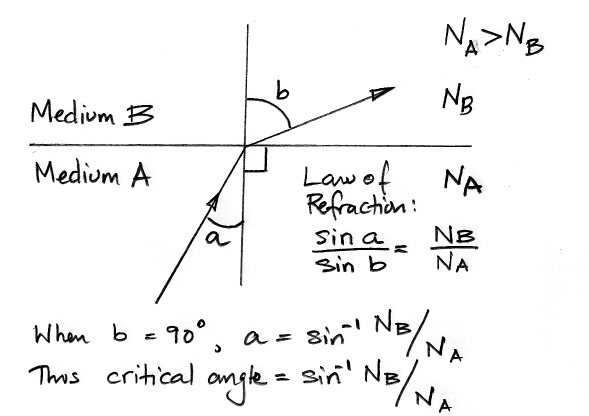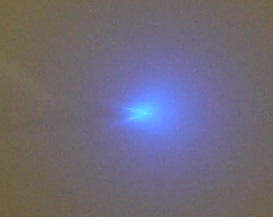The numerical aperture of this fiber is such that any ray within the core that makes less than 14° with the axis will be constrained within the core by total internal reflection at the core-cladding interface. We see no sign of the blue light within the fiber until it reaches the taper. Within the taper, the blue light reflects off the sloping walls of the fiber. These reflections increase the angle the light rays make with the fiber axis. Eventually, the light no longer reflects off the the core-cladding interface, nor even the cladding-air interface. The tip of the fiber shines with blue light.
When a ray of light passes through a decrease in refractive index, its will turn towards the plane of the interface. The diagram below shows how rays with an angle of incidence greater than a critical angle will be reflected.

Our fiber has numerical aperture 0.37, which means rays in air that enter a polished, perpendicular fiber tip will end up propagating down the core if they lie within 22° of the fiber axis. The fiber silica has refractive index roughly 1.58. When a ray at 22° enters a fiber, it bends towards the axis and propagates at an angle of 14°. The critical angle of the core-cladding interface is 76°. The ratio of the core refractive index to the cladding refractive index is 0.97. If we assume the core has refractive index 1.58, the cladding must have refractive index 1.54.
With the taper in air, however, we have the cladding-air interface to perform internal reflection as well. Because the refractive index of air is 1.0, the critical angle of this interface is 40°. In the photograph we see light escaping from the taper only when it gets within 300 μm of the tip. When we immerse the taper in water, however, light starts to escape farther from the tip. The refractive index of water is 1.3, so the critical angle of the cladding-water interface is 50°. The following photograph shows the same fiber tip immersed in water with a suspension of fine particles to scatter the emitted light.
The light starts to escape the fiber roughly 600 μm from the fiber tip. Most of the light emerges within a 90° cone. But the fact that we can see the taper clearly from the side demonstrates that the taper emits in all directions even when immersed in water.

